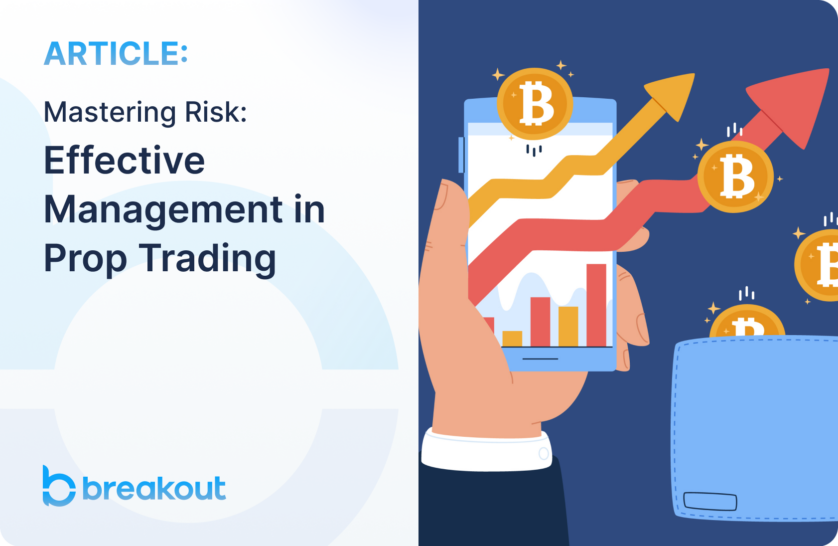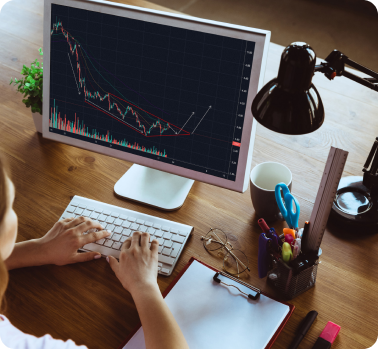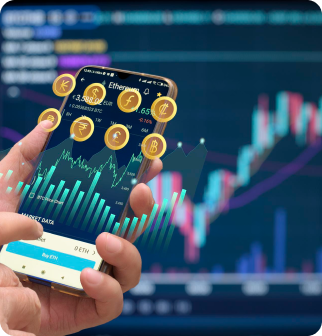


Only a portion of prop traders’ funds should be allocated into any single trade or market
Maintaining a trading journal is a simple but invaluable habit for many successful prop traders
Traders should utilize some of the many market analysis and scanning tools to gain deeper insights into the state of the market
Exercising judicious risk management is a must for prop traders – especially those who aim to be successful. In this detailed analysis, we dive into the nuances of what constitutes effective risk management within the world of proprietary trading and explore a variety of risk management strategies that are fundamental for safeguarding a prop trading firm’s capital.
Risk management is a crucial aspect of the proprietary trading process, encompassing a set of sound risk management practices designed to assist prop traders in responsibly managing their firm’s funds. Effective risk management not only involves adhering to specific risk limits but also integrating advanced risk management software and tools to monitor and mitigate potential risks.
Prop traders, although not required to risk their own money, often find themselves managing significant amounts of the proprietary trading firm’s capital, sometimes up to $400,000. The ability to effectively manage risk exposure and stay within predetermined risk parameters is critical. Failure to do so can lead to adverse market movements severely impacting the firm’s financial stability, resulting in traders losing their funded accounts and abruptly ending their prop trading journey.

Let’s explore some tried-and-tested risk management strategies to manage the inherent risks involved in prop trading. These include setting specific risk limits, using correlation analysis tools to understand market fluctuations, and employing stop loss orders to minimize losses from losing trades. Additionally, prop trading firms must focus on training their prop traders in different trading strategies, ensuring they are well-equipped to handle market conditions and leverage opportunities to generate profits without taking excessive risks.
Ensuring your venture in prop trading does not end before it begins requires a comprehensive understanding of risk exposure, effective risk management practices, and the continuous monitoring of trading positions. By incorporating these elements, prop traders can safeguard themselves and their firms against significant losses and optimize their trading strategy to maximize potential rewards.
Diversification is a cornerstone of sound financial strategy, particularly with the volatility of prop trading and financial markets. Prop traders are advised to spread their investments across multiple asset classes, trading strategies, and financial instruments to mitigate potential risks. This approach helps ensure that a significant loss in one area won’t catastrophically impact the trader’s entire portfolio. To further this strategy, prop trading firms often employ risk management rules and set specific risk limits to curb maximum exposure on single trades or market movements.

Some proprietary trading firms may impose their own leverage limits and position limits to manage risk, but even in the absence of such policies, it is prudent for prop traders to adopt their own stringent risk parameters. These self-imposed limits help protect a proprietary trading firm’s capital from excessive risk due to market fluctuations or adverse market movements.
Stop-loss orders are indispensable tools for effective risk management in prop trading, as they play a critical role in minimizing potential losses. These orders enable prop traders to define a specific price level at which a trade will automatically be closed, preventing further losses and preserving the firm’s capital. This strategic use of stop-loss orders is part of sound risk management practices that help mitigate risks associated with adverse market movements and volatile market conditions.
Similarly, take profit orders are essential for systematically securing profits from trading activities. They function by automatically executing a sale when a trading position reaches a predefined profit level, thus locking in gains. This is particularly important in fast-moving financial markets, where it can be tempting for prop traders to hold on for even higher profits, risking a reversal in market trends that could erase gains. By setting take profit orders, traders can avoid the pitfalls of emotional trading and ensure that they capitalize on trading opportunities without becoming greedy.

Incorporating these orders into a trading strategy helps maintain a disciplined approach to trading, enforcing predetermined price levels for exiting positions, whether to prevent significant losses or to secure profits. This approach allows prop traders to manage risk exposure more effectively by setting specific risk limits and leveraging risk management software to monitor trading positions and market fluctuations.

Moreover, the use of stop-loss and take profit orders is a key component of trading risk management that supports prop trading firms in maintaining a stable risk profile. It enables prop traders to operate within the risk parameters and leverage limits set by their proprietary trading firms, ensuring that the firm’s capital is protected against excessive risk and potential risks are mitigated before they can impact financial outcomes. This disciplined use of trading instruments and strategies is essential for prop traders who aim to sustain profitability and effectively manage the risks involved in proprietary trading.
Employing a disciplined approach to trading is vital for any trader, especially skilled traders in the prop trading sphere. Many experienced prop traders and forex traders will only initiate trades when the potential rewards justify the risks involved. They typically look for trading opportunities where the risk-to-reward ratio is at least 1:2, ensuring that the possible gains are significant enough to rationalize the risk exposure. This strategy, combined with the use of data analytics tools and market data, allows traders to make informed decisions and effectively manage risk exposure, thus maximizing potential rewards while safeguarding against significant losses.
Effective risk management in prop trading involves a multi-faceted approach that includes diversifying trading strategies, employing risk management software, setting and respecting firm-specific risk limits, and utilizing financial tools like stop-loss and take profit orders. These measures help prop traders navigate economic events and trading activities more successfully, enhancing their ability to generate profits while protecting the firm’s capital and their own prop trading journey.

Keeping a meticulous record of every trading activity is a fundamental practice for prop traders, serving as a repository of valuable historical data and insights. A trading journal not only captures the details of each trade but also provides an analytical framework that can guide future trading strategies. This disciplined, structured approach is crucial for anyone involved in prop trading, as it enables traders to critically evaluate their successes and missteps.

A well-maintained trading journal acts as a critical tool for effective risk management, helping traders better understand their risk profile and manage risk exposure more efficiently. It encourages a systematic review of trading positions, trading strategies, and market conditions, allowing traders to refine their approach based on actual performance metrics rather than speculative assumptions. This practice is especially important in the fast-paced world of financial markets, where adverse market movements can swiftly lead to significant losses.
Moreover, a trading journal supports prop traders in developing a comprehensive understanding of different trading instruments and asset classes. It aids in maintaining a clear record of how various strategies perform across different market scenarios, including economic events and market fluctuations. For prop trading firms and individual traders alike, the insights gained from a trading journal are instrumental in tailoring risk management practices and trading strategies to better align with market dynamics and trading opportunities.
By systematically recording and analyzing each trade, prop traders can identify patterns in market movements and their own trading behaviors, leading to more informed decisions and potentially higher returns. This tool not only helps in minimizing losses but also maximizes potential rewards by enabling traders to capitalize on proven strategies and adjust their trading positions accordingly.
Stress testing and scenario analysis are critical components in the toolkit of successful prop traders, providing deep insights into how their portfolios might respond to extreme economic events or dramatic shifts in market conditions. By simulating different market scenarios, from catastrophic crashes to rapid booms, prop traders can better understand potential risks and manage risk exposure more effectively. This proactive approach allows for the refinement of trading strategies and the establishment of specific risk limits to safeguard the firm’s capital.
Such analytical practices enable traders to move beyond mere speculation, offering a structured method to anticipate and prepare for various market outcomes. Scenario analysis helps in identifying adverse market movements that could affect trading positions, enabling traders to implement risk management practices that can mitigate these effects. Additionally, by employing risk management software and data analytics tools, prop traders can gain a more nuanced understanding of the correlation between different trading instruments and asset classes during diverse market phases.

Implementing stress tests and scenario analyses not only helps in managing risk but also enhances the ability to generate profits by better positioning traders to capitalize on trading opportunities when they arise. This strategic planning is essential in prop trading, where managing the balance between potential rewards and risks involved is crucial for long-term success.

Moreover, these tools aid prop traders in developing a robust risk profile, which is vital for maintaining stability within proprietary trading firms. By understanding the impact of market fluctuations on their trading activities, traders can adjust their trading strategies, leverage limits, and position sizing accordingly, thus minimizing potential losses and maximizing returns.
In essence, stress testing and scenario analysis equip prop traders with the necessary foresight and preparedness to handle unexpected market events and ensure the continuous profitability and sustainability of their prop trading journey. This disciplined and systematic approach to anticipating market dynamics is crucial in prop trading, where precise management of both the firm’s capital and personal capital across different scenarios plays a pivotal role in achieving success.
Markets are in a constant state of flux, and a trading strategy that yielded profits last year might not necessarily be effective this year. To remain successful, traders engaged in proprietary trading need to continually evolve their trading strategies by staying informed of the latest market developments, economic events, and regulatory changes. This ongoing process of education and adaptation is crucial for effectively managing risk exposure and maximizing potential rewards.

Moreover, traders should proactively utilize advanced market analysis and scanning tools that offer deep insights into current market conditions. These tools are essential for proprietary trading firms and individual traders alike, as they provide comprehensive data on various trading instruments, including cryptocurrencies. Platforms like Coinalyze and Velo, for instance, deliver critical information on crypto assets such as open interest, funding rates, trade volume, and other key metrics. Such detailed analytics help traders anticipate market movements, manage risk, and refine their trading strategies accordingly.
Additionally, incorporating data analytics tools and risk management software can significantly enhance a trader’s ability to mitigate potential risks and identify trading opportunities. These technologies allow for a more granular analysis of market data and trading positions, facilitating more informed decisions and strategic positioning across multiple asset classes.
Prop traders must also pay close attention to market news and the performance metrics of specific securities to adjust their approaches in line with changing market dynamics. This includes implementing stop loss orders to minimize losses from losing trades and setting specific risk limits to protect the firm’s capital against excessive risk. By continuously adjusting their trading strategies and leveraging state-of-the-art tools, prop traders can better navigate the complexities of financial markets and ensure the sustainability of their prop trading journey.
Continuous education and the strategic adjustment of trading practices are indispensable for prop traders aiming to thrive in the ever-evolving financial markets. By staying informed and effectively leveraging various analytical tools, prop traders can maintain a competitive edge, safeguard their investments, and consistently generate profits even amidst challenging market conditions.
At reputable prop trading firms such as Breakout, there is no requirement to meet minimum daily trade limits, providing prop traders with the freedom to enter trades only when the conditions are most favorable. This approach allows traders to take the time necessary to thoroughly analyze and choose their trading positions without feeling pressured to act hastily.
Moreover, with a diverse range of over 80 crypto assets, along with perpetual futures contracts and options for leveraged trading, prop traders are equipped with multiple avenues to explore potential trading opportunities. This extensive selection enables traders to diversify their portfolios across different asset classes, which can help mitigate risk exposure and enhance the potential for significant profits.
Traders are advised to selectively focus on a few assets that they have researched extensively and understand deeply. Given the complexity and rapid pace of the cryptocurrency market, keeping abreast of market conditions surrounding just a few assets can be challenging. Each digital currency has its own unique set of market events, including token unlock schedules, airdrop dates, partnership announcements, and funding news. These events can significantly influence an asset’s performance in the market.
By concentrating on specific securities, traders can develop a more focused and effective trading strategy, leveraging data analytics tools and market data to make informed decisions. This selective approach not only helps in managing risk but also positions traders to better capitalize on market movements and trading opportunities. Prop traders can thus maximize their potential rewards by aligning their trading activities with the most current and relevant economic events and market news, ensuring they are well-prepared to respond to the dynamics of the financial markets.

Effective risk management is crucial for safeguarding the portfolio and capital of a prop trading firm. Prop traders can utilize a range of tools—from basic trading journals to advanced risk management software and data analytics tools—to monitor market fluctuations and optimize trading strategies.

Successful traders implement specific risk limits and use correlation analysis tools to manage potential risks and adverse market movements effectively. They diversify their trading positions across multiple asset classes using various trading instruments and position sizing techniques, minimizing the impact of losing trades and maximizing potential rewards.
By consistently applying these risk management techniques and staying informed about market conditions through continuous monitoring of market news and economic events, prop traders enhance the financial health and sustainability of their prop trading journey. This disciplined approach ensures that they are well-prepared to adapt to market changes and capitalize on new trading opportunities.